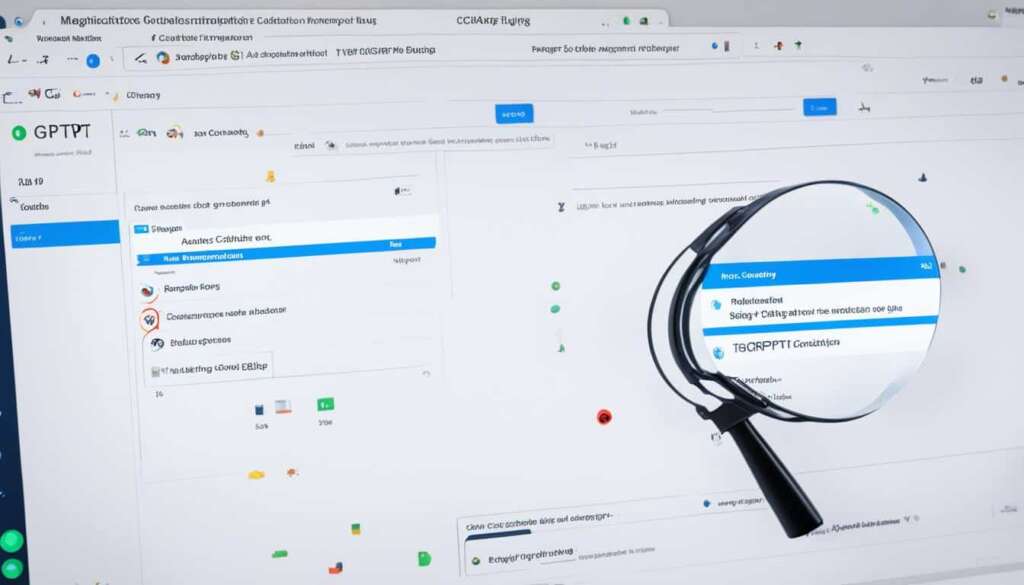Table of Contents
ChatGPT, an advanced language model developed by OpenAI, offers a unique bug detection capability that is highly valuable in the field of software development. With its ability to analyze small code snippets, ChatGPT can efficiently identify bugs and provide insightful explanations to aid developers in resolving them.
While ChatGPT’s bug detection capability is limited to smaller code pieces, typically consisting of less than a hundred lines of code, it surpasses other static analysis tools in terms of the quality of its bug explanations.
However, it is important to note that ChatGPT might occasionally make mistakes in bug detection or provide suggestions for fixes that are influenced by the specific question asked. This can potentially confuse inexperienced programmers, highlighting the need for caution and critical evaluation when utilizing ChatGPT’s bug detection functionality.
To complement ChatGPT’s bug detection capabilities, OpenRefactory’s Intelligent Code Repair (iCR) integrates with Large Language Models (LLMs) like ChatGPT, extending the capability to find bugs that other tools might miss. Not only does iCR provide low false warning rates, but it also offers better fixes for complex problems, ensuring developers can rely on a comprehensive approach to bug detection and resolution.
In the following sections, we will delve deeper into evaluating ChatGPT’s bug-finding performance, exploring its application in debugging Python code, presenting test results, and concluding with insights into its effectiveness as a valuable tool for developers in the field of software development.
Evaluating ChatGPT’s Bug-Finding Performance
When it comes to bug finding in code snippets, ChatGPT proves to be a formidable contender among other code-fixing systems. While initial performance may be on par with other systems, ChatGPT’s unique ability to engage in dynamic dialogue and gather additional information sets it apart, leading to superior bug detection capabilities.
In a recent evaluation, ChatGPT successfully identified and fixed 31 out of 40 bugs, outperforming competing systems in the process. This impressive bug-fixing performance can be attributed to ChatGPT’s conversational approach, enabling it to gain a deeper understanding of the code and uncover subtle issues that may have evaded static analysis tools.
One noteworthy observation is ChatGPT’s higher variance in bug fixing, indicating that running requests multiple times can yield even better results. By leveraging the opportunity to engage with ChatGPT iteratively, developers can potentially enhance the effectiveness of bug detection and resolution.
Compared to traditional program repair methods, ChatGPT’s bug-fixing performance proved to be competitive with deep learning approaches while showcasing key advantages over more conventional approaches. The study’s findings highlight ChatGPT as an increasingly valuable tool in the realm of bug finding and code improvement.
| Bugs Fixed | Performance Comparison | |
|---|---|---|
| ChatGPT | 31 out of 40 | Outperformed other systems |
| Deep Learning Approaches | Variety of Results | Competitive with ChatGPT |
| Traditional Program Repair Methods | Lower Bug-Fixing Performance | Outperformed by ChatGPT |
Using ChatGPT for Debugging Python Code
ChatGPT can be a powerful tool for debugging Python code. It offers a range of features that enable developers to quickly identify and fix various errors, ensuring the smooth execution of their programs.
When it comes to bug detection, ChatGPT surpasses expectations by pinpointing common issues such as missing module imports, undefined variables, division by zero, and modifying lists while iterating over them. By detecting these bugs early on, developers can save valuable time and effort in the debugging process.
“ChatGPT’s ability to offer multiple solutions is particularly valuable. It not only identifies bugs but also provides suggestions for improving the overall code structure. This comprehensive approach enables developers to choose the best option for their specific needs.”
By leveraging ChatGPT’s debugging capabilities, developers can enhance their workflow and improve the quality of their code. With its intelligent insights and recommendations, developers can make informed decisions and write more efficient and reliable Python code.
Example:
Let’s consider an example scenario where ChatGPT is used to debug Python code:
- A developer encounters a bug in their code where they have forgotten to import a necessary module.
- They turn to ChatGPT and provide the code snippet for analysis.
- ChatGPT quickly identifies the missing module import and provides the correct statement to resolve the issue.
- The developer implements the suggested fix, and the bug is eradicated.
This example illustrates how ChatGPT’s debugging capabilities can streamline the development process and ensure the smooth functioning of Python code.
ChatGPT’s Bug Detection and Debugging Capabilities for Python Code
| Error Type | ChatGPT’s Detection | ChatGPT’s Fix |
|---|---|---|
| Missing Module Imports | ✓ | Provides the correct import statement |
| Undefined Variables | ✓ | Identifies the undefined variables |
| Division by Zero | ✓ | Suggests alternative approaches to avoid division by zero |
| Modifying Lists While Iterating | ✓ | Offers strategies to prevent modifying lists during iteration |
Table: ChatGPT’s bug detection and debugging capabilities for Python code. ChatGPT accurately identifies common errors and provides effective solutions for a seamless debugging experience.
Test Results: ChatGPT’s Effectiveness in Debugging Code
In order to assess the effectiveness of ChatGPT in debugging code, several tests were conducted. These tests aimed to evaluate ChatGPT’s ability to handle different code errors and error scenarios. The results demonstrated ChatGPT’s proficiency in identifying and resolving code bugs, as well as its capability to suggest improvements for future issues.
Test 1: Missing Module Imports
Test 1 focused on assessing ChatGPT’s ability to handle missing module imports. During the test, ChatGPT successfully identified the error and provided the correct import statement. This demonstrates ChatGPT’s capability to effectively detect and address missing module imports, minimizing code errors.
Test 2: Undefined Variables
Test 2 evaluated ChatGPT’s performance in cases where variables were not defined. ChatGPT accurately pointed out the issue, showcasing its competence in identifying and resolving undefined variables. By addressing these errors, ChatGPT aids in enhancing the robustness and reliability of the code.
Test 3: Division by Zero Errors
In Test 3, the focus was on examining division by zero errors. ChatGPT swiftly identified and remedied the problem, showcasing its proficiency in detecting and resolving division by zero errors. By preventing such errors, ChatGPT contributes to the overall integrity and accuracy of the code.
Test 4: Modifying Lists While Iterating Over Them
The fourth test aimed to evaluate ChatGPT’s effectiveness in handling code errors related to modifying lists while iterating over them. ChatGPT effectively resolved these errors, showcasing its competence in detecting and addressing this specific scenario. By rectifying these issues, ChatGPT assists developers in writing more efficient and error-free code.
In conclusion, ChatGPT’s performance in the conducted tests demonstrated its effectiveness in debugging code. Whether it be handling missing module imports, identifying undefined variables, resolving division by zero errors, or addressing issues with modifying lists, ChatGPT showcased its capability to detect and fix code errors. Additionally, ChatGPT provided insightful suggestions for preventing future issues, further enhancing the code’s quality and reliability.
Conclusion
ChatGPT’s bug detection capability is a valuable tool for developers, offering clear explanations and alternative fixes for small code snippets. Its quality in bug explanations outperforms other static analysis tools, providing developers with insightful guidance.
While ChatGPT is not intended to handle larger projects or replace existing static analysis tools completely, it excels in debugging Python code. By leveraging ChatGPT’s abilities, developers can enhance their workflow and increase productivity, resulting in improved overall code quality.
As further research and development in this area progresses, we can expect even more advanced bug detection capabilities. ChatGPT’s potential for enhancing software development workflows and its expertise in debugging code errors make it a promising resource for developers striving to write efficient and robust software.
FAQ
What is ChatGPT’s bug detection capability?
ChatGPT’s bug detection capability is limited to small code snippets, typically less than a hundred lines of code. It outperforms other static analysis tools in terms of the quality of its bug explanations.
Does ChatGPT make mistakes in bug detection and suggestion of fixes?
Yes, ChatGPT does make mistakes in bug detection and suggestion of fixes. Its answers can be influenced by the question asked, potentially confusing inexperienced programmers.
How does OpenRefactory’s Intelligent Code Repair (iCR) work with ChatGPT?
OpenRefactory’s iCR integrates with Large Language Models (LLMs) like ChatGPT to find bugs that other tools miss, provide low false warning rates, and offer better fixes for complex problems.
How does ChatGPT perform compared to other code-fixing systems?
In an evaluation comparing ChatGPT to other code-fixing systems, ChatGPT initially performed similarly to other systems. However, its ability to engage in a dialogue and gather more information resulted in it outperforming other systems in bug detection, fixing 31 out of 40 bugs.
Is running multiple requests beneficial when using ChatGPT for bug fixing?
Yes, running requests multiple times can be beneficial as ChatGPT showed higher variance in bug fixing. This indicates that running requests multiple times can improve bug-fixing performance.
What types of errors can ChatGPT identify and fix in Python code?
ChatGPT can quickly identify and fix various errors in Python code, including missing module imports, undefined variables, division by zero, and modifying lists while iterating over them. ChatGPT also provides suggestions for improving the overall code structure.
How can developers benefit from using ChatGPT for debugging Python code?
Developers can save time and effort by leveraging ChatGPT’s debugging capabilities. It not only identifies bugs but also provides suggestions for improvements. Its ability to offer multiple solutions allows developers to choose the best option for their specific needs.
What were the results of the tests conducted to evaluate ChatGPT’s bug-fixing ability?
Test 1 assessed ChatGPT’s ability to handle missing module imports, and it successfully identified the error and provided the correct import statement. Test 2 evaluated ChatGPT’s performance in cases where variables were not defined, and it accurately pointed out the issue. Test 3 examined division by zero errors, with ChatGPT swiftly identifying and remedying the problem. Test 4 focused on modifying lists while iterating over them, and ChatGPT effectively resolved the error. In all tests, ChatGPT not only fixed the bugs but also suggested improvements to prevent future issues.
Can ChatGPT handle larger projects or replace existing static analysis tools?
No, ChatGPT’s bug detection capability is beneficial for small code snippets only. While it outperforms other static analysis tools in terms of bug explanations, it is not capable of handling larger projects or fully replacing existing static analysis tools.
How can developers enhance their workflow and improve the quality of their code using ChatGPT?
By leveraging ChatGPT’s abilities, developers can enhance their workflow, increase productivity, and improve the overall quality of their code. ChatGPT’s debugging capabilities can be a valuable tool for developers, particularly in debugging Python code.
What is the potential for further development in ChatGPT’s bug-detection capabilities?
Further research and development in this area will likely lead to even more advanced bug-detection capabilities in ChatGPT.













